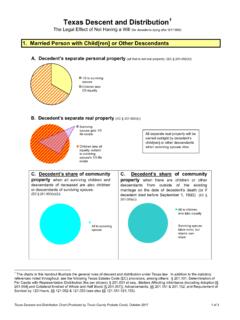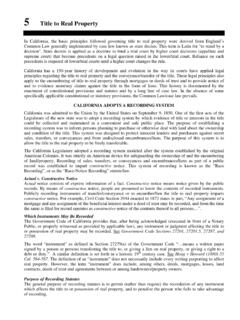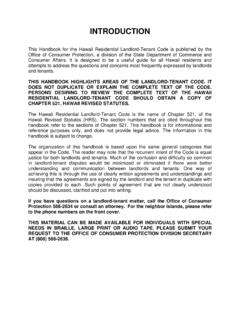Transcription of on the assessment of the risk of ... - European Commission
1 EN EN European Commission Brussels, COM(2019) 370 final REPORT FROM THE Commission TO THE European PARLIAMENT AND THE COUNCIL on the assessment of the risk of money laundering and terrorist financing affecting the internal market and relating to cross-border activities {SWD(2019) 650 final} 1 1. INTRODUCTION Article 6 of the 4th Anti-Money Laundering Directive1 mandates the Commission to conduct an assessment of money laundering and terrorist financing risks affecting the internal market and relating to cross border activities and to update it every two years (or more frequently if appropriate). This report updates the Commission s first supranational risk assessment published in It assesses the implementation of the Commission s recommendations and evaluates remaining risks, including in new products and sectors.
2 The report provides a systematic analysis3 of the money laundering or terrorist financing risks of specific products and services. It focuses on vulnerabilities identified at EU level, both in terms of legal framework and in terms of effective application and provides recommendations for addressing them. This supranational risk assessment takes into account the requirements of the 4th Anti-Money Laundering Directive,4 which was due to be transposed by July 2017. Additional changes brought by the 5th Anti-Money Laundering Directive,5 due to be transposed by January 2020, have been anticipated when defining the new mitigating measures. 2. OUTCOMES OF THE SUPRANATIONAL RISK assessment In this second supranational risk assessment , the Commission identified 47 products and services that are potentially vulnerable to money laundering/terrorist financing risks, up from 40 in 2017.
3 These products and services fall under 11 sectors, including the 10 sectors or products identified by the 4th Anti-Money Laundering Directive6 along with 1 additional category of products and services relevant for the risk 1 Directive (EU) 2015/849 of the European Parliament and of the Council of 20 May 2015 on the prevention of the use of the financial system for the purposes of money laundering or terrorist financing, amending Regulation (EU) 648/2012 of the European Parliament and of the Council, and repealing Directive 2005/60/EC of the European Parliament and of the Council and Commission Directive 2006/70/EC, OJ L 0849, , 2 Report from the Commission to the European Parliament and the Council on the assessment of the risks of money laundering and terrorist financing affecting the internal market and relating to cross-border activities, COM(2017) 340 final.
4 3 For a more detailed description of the methodology, see the Staff Working Document accompanying this Report SWD(2019) 650. 4 Although the 5th Anti-Money Laundering Directive has been adopted, its transposition deadline has not yet passed. Similarly, the 2017 supranational risk assessment was drafted when the 4th Anti-Money Laundering Directive had been adopted, but its transposition deadline had not yet passed. 5 Directive (EU) 2018/843 of the European Parliament and of the Council of 30 May 2018 amending Directive (EU) 2015/849 on the prevention of the use of the financial system for the purposes of money laundering or terrorist financing, and amending Directives 2009/138/EC and 2013/36/EU (Text with EEA relevance); PE/72/2017/REV/1; OJ L 156, , p.
5 43 74. 6 Credit and financial institutions, money remitters, currency exchange offices, high value goods and assets dealers, estate agents, trust and company service providers, auditors, external accountants and tax advisors, notaries and other independent legal professionals, and gambling service providers. 7 This category includes cash-intensive businesses, virtual currencies, crowdfunding and non-profit organisations. It also covers certain informal means, such as those used by Hawala and other informal value transfer service providers; and four new products/sectors that were not assessed in the 2017 report: privately owned automated teller machines; professional football; free ports; and investor citizenship and residence schemes.
6 2 Main risks in the sectors covered by the supranational risk assessment Cash and cash-like assets Law enforcement agencies findings show that, while cash is falling out of favor among consumers, it remains criminals money laundering instrument of choice as they can use cash to transfer funds rapidly from one location to another, including in air transit. Use of cash is the main trigger for the filing of suspicious transaction reports. Criminals who accumulate cash proceeds seek to move them to locations where they can more easily be integrated into the legal economy, those characterised by predominant use of cash, lax supervision of the financial system and strong bank secrecy regulations. Since the 2017 supranational risk assessment , the relevant legal framework has been strengthened.
7 The 4th Anti-Money Laundering Directive covers traders of goods who make or receive cash payments of EUR 10,000 or more. Member States can adopt lower thresholds, additional general restrictions on the use of cash and stricter provisions . The revised Cash Controls Regulation8 applicable from 3 June 2021 extends the obligation of any traveller entering or leaving the EU and carrying cash to a value of EUR 10,000 or more to declare it to the customs authorities. It also extends the definition of cash, to cover not only banknotes but also other instruments or highly liquid commodities, such as cheques, traveller's cheques, prepaid cards and gold. Assets with similar properties to cash ( gold, diamonds) or high-value lifestyle goods ( cultural artefacts, cars, jewellery, watches) are also high-risk, due to weak controls.
8 Specific concerns have been expressed as regards the looting and trafficking of antiquities and other artefacts. In this regard, the recently adopted Regulation on import of cultural goods complements the existing EU legal framework on their trade, which until now has only included legislation covering the export of cultural goods and the return of cultural objects unlawfully removed from the territory of an EU Financial sector The report on the assessment of recent alleged money laundering cases involving EU credit institutions identifies the factors that contributed to, as well as lessons learnt from, recent money laundering cases in EU banks, with a view to informing further policy actions. It assesses failures related to credit institutions anti-money laundering and defences and highlights challenges associated with different approaches to anti-money laundering/countering the financing of terrorism supervision at national level (see point ).
9 Moreover, some other financial subsectors or products that deal with cash ( foreign exchange offices, transfers of funds, and some e-money products) still pose significant money laundering risks, especially in case of unscrupulous behaviour on the part of third parties who act in their delivery channels, as agents or 8 Regulation (EU) 2018/1672 of the European Parliament and of the Council of 23 October 2018 on controls on cash entering or leaving the Union and repealing Regulation (EC) No 1889/2005, OJ L 284, , p. 6 21. 9 Regulation (EU) 2019/880 of the European Parliament and of the Council of 17 April 2019 on the introduction and the import of cultural goods; PE/82/2018/REV/1; OJ L 151, , p.
10 1 14. 10 On April 2019 The European Banking Authority published an Opinion on the nature of passport notifications of payment institutions and electronic money institutions using agents and distributors located in another Member State: 3 The use of new technologies (FinTech)11that enable speedy and anonymous transactions with increasingly non-face-to-face business relationships, while bringing considerable benefits, may pose a higher risk if customer due diligence and transaction monitoring are not conducted efficiently across the delivery While the 5th Anti-Money Laundering Directive provisions on virtual currency providers and custodian wallet providers are a first regulatory step, the increasing use of such instruments is posing higher risks and further regulatory steps may be needed.
















